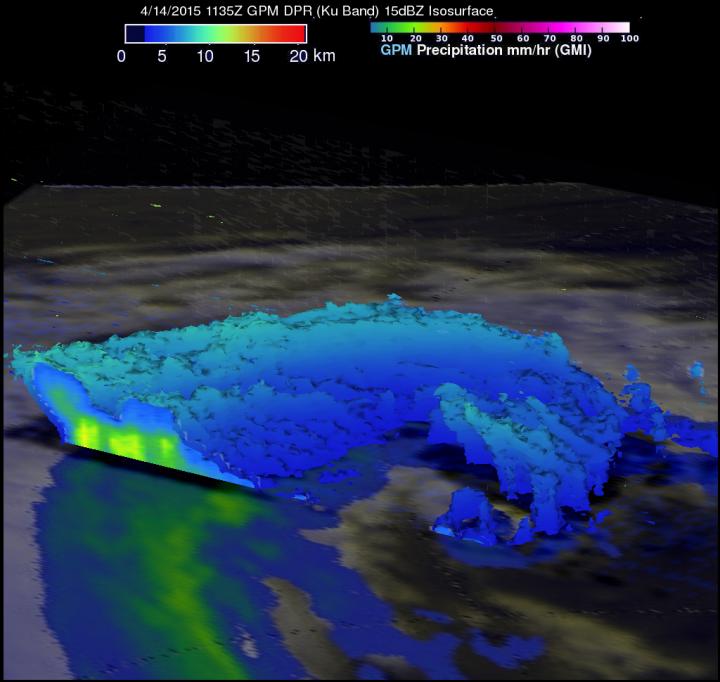GPM sees wind shear affecting remnants of Extra-tropical Cyclone Joalane

GPM data from April 14 showed that Joalane's highest storm tops were as high as 9.37 km (5.8 miles) in rain bands south of Joalane's center of circulation. Image Credit: SSAI/NASA, Hal Pierce
The Global Precipitation Measurement (GPM) core observatory satellite had a last look at the remnants of Tropical Cyclone Joalane on April 14, 2015 at 1135 UTC (4:35 p.m. local time/7:35 a.m. EDT/U.S.).
GPM's Microwave Imager (GMI) instrument found very little rainfall around Joalane's center and light to moderate rainfall in bands on the outer edges of the rapidly weakening tropical cyclone.
At NASA's Goddard Space Flight Center in Greenbelt, Maryland, reflectivity data derived from the Ku band on GPM's dual frequency radar was used to create a three-dimensional image of the extra-tropical cyclone.
The 3-D image showed cloud tops were tilted toward the south, clearly indicating how strongly vertical shear was affecting the rapidly weakening tropical cyclone. GPM data showed that Joalane's highest storm tops were as high as 9.37 km (5.8 miles) in rain bands south of Joalane's center of circulation.
Joalane continued to weaken and is expected to dissipate in a day or two.
Media Contact
All latest news from the category: Earth Sciences
Earth Sciences (also referred to as Geosciences), which deals with basic issues surrounding our planet, plays a vital role in the area of energy and raw materials supply.
Earth Sciences comprises subjects such as geology, geography, geological informatics, paleontology, mineralogy, petrography, crystallography, geophysics, geodesy, glaciology, cartography, photogrammetry, meteorology and seismology, early-warning systems, earthquake research and polar research.
Newest articles

Bringing bio-inspired robots to life
Nebraska researcher Eric Markvicka gets NSF CAREER Award to pursue manufacture of novel materials for soft robotics and stretchable electronics. Engineers are increasingly eager to develop robots that mimic the…

Bella moths use poison to attract mates
Scientists are closer to finding out how. Pyrrolizidine alkaloids are as bitter and toxic as they are hard to pronounce. They’re produced by several different types of plants and are…

AI tool creates ‘synthetic’ images of cells
…for enhanced microscopy analysis. Observing individual cells through microscopes can reveal a range of important cell biological phenomena that frequently play a role in human diseases, but the process of…





















